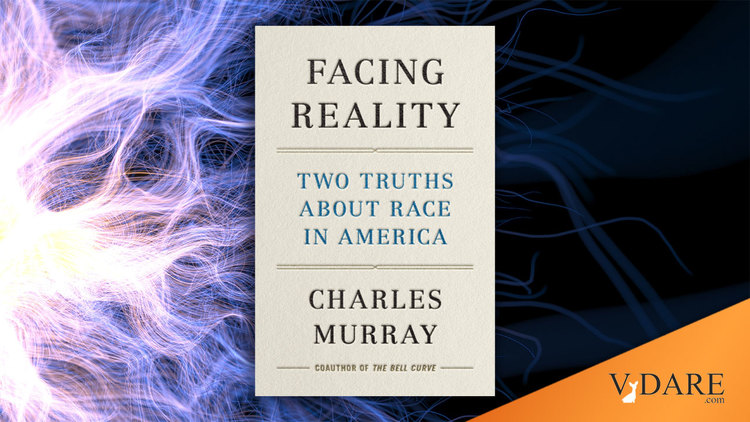
By Jared Taylor
06/23/2021
Sometimes, a single brave man can break a taboo. Nicholas Wade’s carefully argued May 5 article in the Bulletin of the Atomic Scientists broke the ban on the lab-leak view of the origins of Covid-19. In just a few days, articles on a possible lab leak appeared in the Washington Post (twice), the New York Times (twice), and the Wall Street Journal. Suddenly, what the tech censors had banned as a “conspiracy theory” was legitimate. President Biden ordered an investigation.
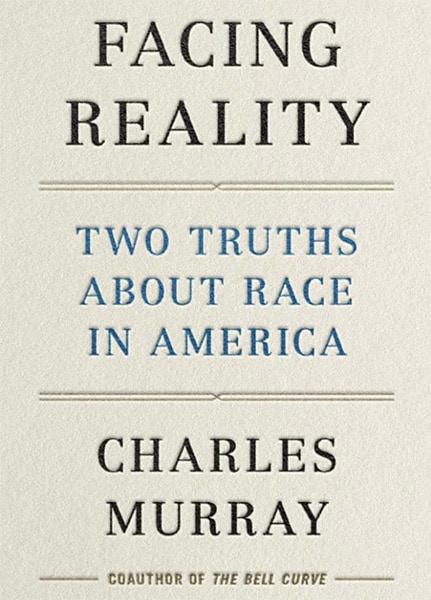
For years, I have wondered how the taboo on talking about racial differences will collapse. Could one brave man break the logjam? Charles Murray gives it a try in his latest book, Facing Reality: Two Truths About Race in America,. I cheer the effort, and Dr. Murray has made powerful arguments, but much as I hope he succeeds, I think he will fail.
First — and least important — the book could be more persuasive. Second — and much more important — Dr. Murray is already notorious, as the SPLC puts it, for “using racist pseudoscience and misleading statistics to argue” for “the genetic inferiority of the black and Latino communities.” If one man could end the taboo, he would have to be famous, beloved, and untainted. Tim Cook? Anthony Fauci? Maybe there is no such person.
But aside from whether one man could turn the tide, the very purpose of Facing Reality is hopelessly wrong: Dr. Murray says the reason we have to bring the truth to light is to prevent whites from realizing they have racial interests. “If working-class and middle-class Whites adopt identity politics,” he writes, “disaster follows.” Whites must wait quietly while wise men like Dr. Murray talk everyone else out of their “identity politics” and usher in an age of racial reconciliation.
Race and IQ
Facing Reality is about two realities: racial differences in IQ and race differences in crime rates. Dr. Murray thinks that decades of denying and even concealing facts about race has led to a frightening crisis. “I am now slower to assume that we will avoid catastrophe,” he writes, adding, “The prospect of legal secession may be remote, but the prospect of reduced governability from Washington is not.”
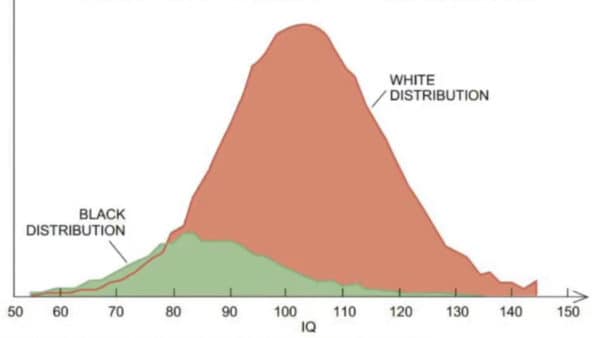
Dr. Murray is absolutely right to argue that race denial falsifies almost every political debate. He is also right to blame cowardice: “Well-meaning people on the right are as uncomfortable confronting the reality of group differences as well-meaning people on the left.” (Are people who have “confronted this reality” for years not well-meaning?)
Furthermore, “these facts [about race] have been distorted and exploited from malign purposes by racist and hateful people” (who might they be?), and well-meaning people wouldn’t want to be thought “racist and hateful.” But cowardice leads straight into a trap: “Since we have been unwilling to say that [races differ in ability], we have been defenseless against claims that racism is to blame for unequal outcomes.”
People like Ibram Kendi and Ta-Nehisi Coates have built spectacular careers out of white cowardice. If whites dare not deny that the races are perfectly equal, they have no answer to hustlers who blame whites for every black (and Hispanic) failing. Facing Reality counters this by ably summarizing the overwhelming evidence for the following: Demanding jobs require high intelligence (and intelligence helps even on undemanding jobs); IQ tests measure intelligence; they are not biased against non-whites; and on average, Asians are smarter than whites, who are smarter than Hispanics, who are smarter than blacks. Dr. Murray writes that hundreds of billions of dollars have been spent to reduce the racial gaps, and though there was some convergence in average test scores from 1972 to 1987, in the last 34 years, the gaps have, if anything, widened.
Only in our desperately egalitarian world is this controversial, but it blows to bits the entire foundation for today’s Left. Dr. Murray calculates that blacks and Hispanics combined make up the following percentages at the following IQ levels: IQ of 115: 15 percent; IQ of 125: 10 percent; IQ of 140: 4 percent.
For this reason, blacks (13 percent of the population) and Hispanics (18 percent), who combined make up 31 percent of the population, cannot possibly be expected to fill top jobs in proportion to their numbers. And they don’t. As Dr. Murray writes, “these results will occur in the absence of any racism whatsoever.” However, blacks and Hispanics benefit from race preferences every step of the way. Therefore, as Dr. Murray notes:
[T]he picture flips [and they are overrepresented in high-level jobs] when race differences in cognitive ability and job performance are taken into account. Africans and Latins get through the educational pipeline with preferential treatment in admissions to colleges and the professional programs. Their mean IQs and occupations across the range from unskilled to those requiring advanced degrees are substantially lower than the mean IQs for Europeans in the same occupations.
College does not winnow out less capable blacks and Hispanics to the extent it does whites. “Underrepresented” minorities are shepherded through to graduation with inflated grades in undemanding majors.
The result is that in all professions, there are huge averages differences in intelligence. This table is worth studying carefully. (p. 76)
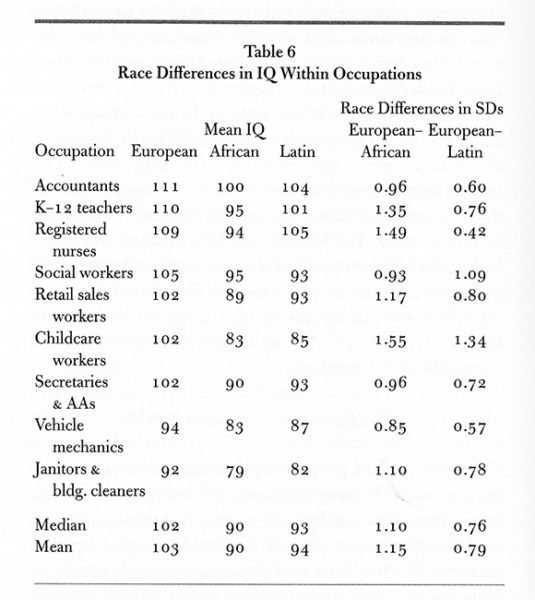
Average IQ differences this great inevitably mean large differences in ability, which are reflected in job-performance evaluations. The IQ gaps for nurses and K-12 teachers are stark. Schools and hospitals would surely prefer to hire only the best candidates, but as Dr. Murray points out, they would end up with so few “underrepresented minorities” they would be sued.
Dr. Murray reports that the average race differences in test scores for graduate school (GRE), law school (LSAT), and medical school (MCAT) are greater than the average IQ differences in the general population. This does not stop post-graduate schools from bending admissions criteria even more than in colleges so as to get a “representative” number of blacks and Hispanics. They then fail qualifications tests at greater rates, and those who pass make it into demanding professions at the bottom of the required ability levels.
The following two tables give a sense of the consequences. The data are from California but are probably representative. p. 143, p. 144.
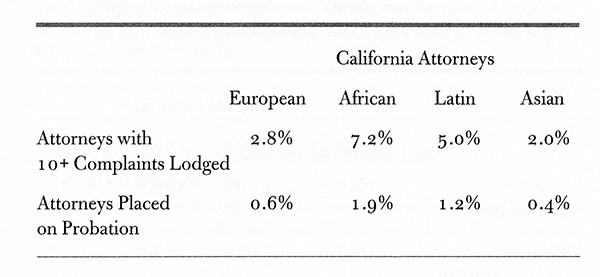
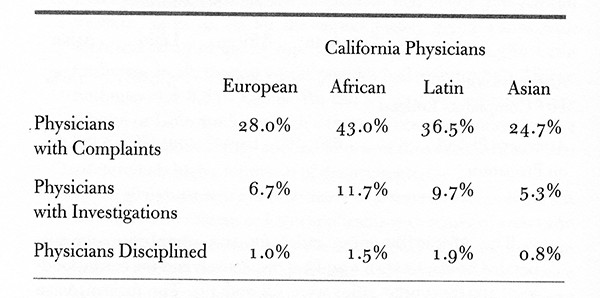
The obligatory explanation is that white prejudice explains high complaint and discipline rates. Probably, though, there would be more complaints and discipline if whites were not so afraid of accusations of racism.
Dr. Murray slips into irony at the end of his chapter on race and employment:
The American job market is indeed racially biased. A detached observer might even call it systemic racism. The American job market systematically discriminates in favor of racial minorities other than Asians.
Race and Crime
It is astonishing that there are still people who believe — or at least claim — that blacks and Hispanics are arrested at higher rates than whites and Asians only because of police racism. The idea of bigoted officers rounding up innocent blacks and looking the other way as whites rob or rape is absurd, but not, apparently, to The New York Times and the “defund the police” movement.
Dr. Murray patiently explains that there are excellent survey data from violent-crime victims about the race of their attackers. We therefore know the proportions of black and white offenders, and we know that violent black criminals are somewhat less likely than whites to be arrested. This is probably because so many black crime victims refuse to cooperate with the police.
National data usually fail to distinguish whites from Hispanics, which muddies racial comparisons, but some cities still keep careful records. This table (p. 51) compares the white multiples of the arrests for blacks and Hispanics in 13 cities. In New York City, from 2006 to 2019, blacks were 11.6 times more likely than whites to be arrested for violent crimes; Hispanics were 4.1 times more likely. In Washington, DC, the multiples were 19.9 and 6.4.
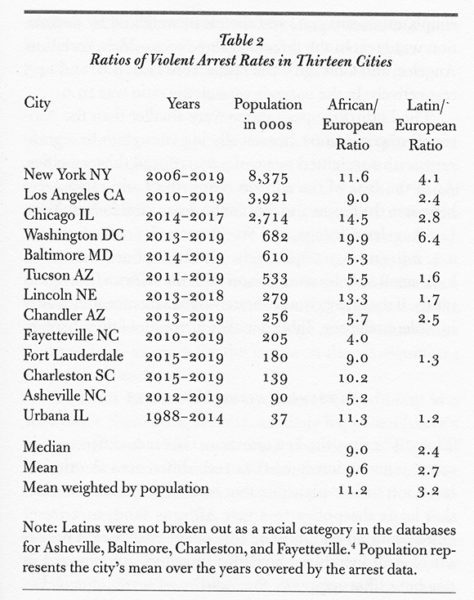
Some figures are astronomical. For example, in 2014 (p. 6 in source), a black was 98.4 times more likely and a Hispanic was 23.6 times more likely than a white to be arrested for a “shooting” in which someone was hit but not killed. Dr. Murray does not make this calculation, but in a theoretically all-white New York City, murder would drop by 90.2 percent and rape by 80.8 percent.
In New York City (and elsewhere) whites almost never kill blacks. Dr. Murray explains: “Of the 1,906 African deaths in the New York shootings database for which the race of the perpetrator is known, 89 percent were killed by Africans. Ten percent were killed by Latins. Just 0.6 percent were killed by Europeans.”
Surprisingly, Facing Reality says almost about the country’s chic obsession with police shootings. If anything, the malignant fantasy of white policeman executing innocent blacks — that any black man could die at any time — poisons American race relations more than do brute differences in crime rates. This book is also silent on rates of black and Hispanic violence against whites — which are staggering.
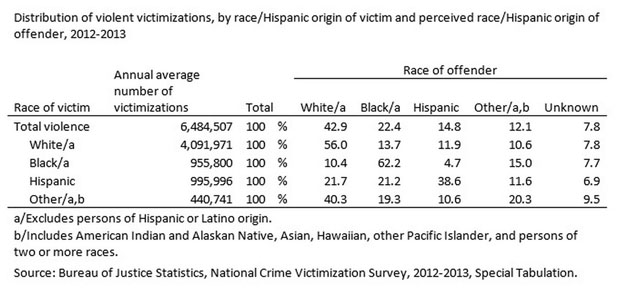
Also, perhaps because he took such a beating for The Bell Curve, Dr. Murray makes unnecessary concessions to the left:
The American criminal justice system needs reform on many fronts. Inconsistencies in sentencing, including racial injustices, are a problem. Uneven enforcement of drug laws is a problem. Overuse of imprisonment is a problem. The militarization of the police is a problem.
These claims come out of the blue, without sources or footnotes. What even is “militarization of the police”? Has there been a plague of black men crushed under the wheels of police Humvees that I missed? Have the media buried stories about police shooting up black neighborhoods with “assault rifles”?
But Dr. Murray makes the most breathtaking concession when he moves from race and IQ to race and crime: “Causes are as irrelevant to the purposes of this chapter as they were to the discussion of cognitive ability.” Causes are crucial.
Our rulers have a blind belief, not only in white racism, but in the power of environment. Even if they concede Dr. Murray’s facts, nothing will stop “progressives” from insisting that black IQ will rise, and crime rates will fall when we finally “root out systemic racism.” Any argument about race and IQ that ignores genetics is crippled from the start. Dr. Murray is well aware of genetic race differences. His previous book, Human Diversity, is stuffed with them. Why ignore them now?
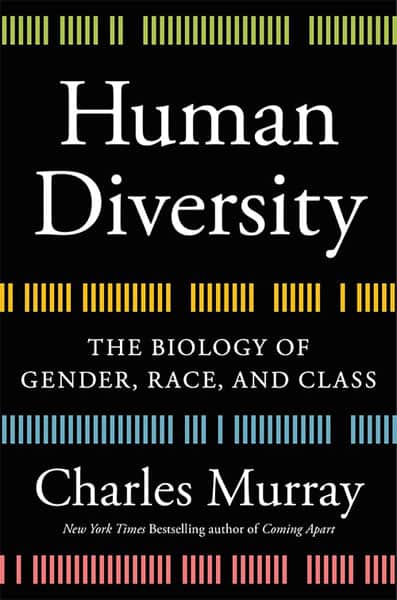
So, what is the country supposed to do about the reality Dr. Murray wants us to face? First, and obviously, we should consider IQ as a possible reason for race differences in behavior. “I don’t ask for much,” he writes. “I will be gratified if researchers are buffered from accusations of racism because they entered IQ scores as an independent variable in a regression equation.” Alas, that is asking for the moon. It would upend every “progressive” assumption. That would be a nice start, but Dr. Murray doesn’t let whitey off the hook:
My own overarching position is that racism persists in America, but it persists in spite of the American system and its institutions, not because of them … . These problems [that beset American society] are exacerbated by individual racism. The racism is not systemic.
It’s nice to know that the racism is not “systemic,” but where does “individual racism” come from? Donald Trump? Derek Chauvin? Hunter Biden? How, after decades of trying, are we going to eliminate this “individual racism,” which, moreover, appears to be an exclusively white malady?
Dr. Murray also dismisses conventional uplift programs: “The places where the need for social interventions is greatest are the places where they have the least chance of working … . Attempts to stimulate economic growth in places with high crime rates work only in places that are gentrifying or can be gentrified.” That is why “each new attempt to revitalize inner cities for the people who already live there [emphasis in the original]” will fail. And, finally, this harsh assessment: “The land occupied by the inner city really is potentially worth a lot of money if — but only if — the minority residents are replaced through gentrification.” In other words, large concentrations of blacks — and perhaps poor Hispanics as well — can’t be helped. So, what are we to do with them? Sprinkle them throughout the remaining white neighborhoods?
Dr. Murray does throw whites a few bones: “Working-class and middle-class whites who now see themselves as second-class citizens in the eyes of the government aren’t making it up … . Aggressive affirmative action is a poison leaking into the American experiment. We are now dealing with nearly sixty years of accumulated toxin.”
And this is very good:
Blacks, constituting 13 percent of the population, are telling Whites, 60 percent of the population, that they are racist, bad people, the cause of blacks’ problems, and they had better change their ways or else. Right or wrong, that rhetoric is guaranteed to produce backlash by some portion of the 60 percent against the 13 percent. So far, this effect has been masked because the strategy has worked so well with White elites. Ordinarily, you can’t insult people into agreeing with you, but White guilt is a real thing. In the summer of 2020, many White college students and young adults agreed that they had sinned, even though they hadn’t realized it until now, and joined in Black Lives Matter marches … . Meanwhile, many middle-class and working-class Whites have not been insulted into agreement. They’re just insulted, and to their minds unfairly insulted.
But Dr. Murray is very clear about what these undeceived whites are supposed to do: nothing. They are to wait obediently for Joe Biden and political leaders of both parties to take Dr. Murray’s advice to them: end all race preferences, denounce the idea of “systemic racism,” and recognize that “identity politics is an existential threat to the American experiment.”
If Dr. Murray thinks that is going to happen, or that non-whites are suddenly going to become happy, raceless Americans, he is — to put it politely — mistaken. And how can he possibly believe that lefties will buy his argument for why they should recognize race differences in ability? It goes like this: “In order to smother white consciousness, we have to recognize race differences in IQ so that we can end ever-more-blatant race preferences. Push whites too far, and they might get their backs up.” The lefty reply will be, “What? We’re supposed to stop white supremacy by saying that blacks are stupid?”
Dr. Murray says whites must wait for miracles. This is because the most dangerous possible consequence of minority chauvinism is not the destruction of all standards in the name of “equity.” It is not the continued march of black and Hispanic incompetents into high positions. It is not the burden of guilt and humiliation whites are made to bear. It is not the corruption of everything from classical music to the study of ancient Greece and even mathematics because they are “white supremacist.” It is not the atmosphere of anti-white hatred that is already driving some blacks to kill any whites they can find. No, the worst thing that could happen is that whites might realize they are a race with legitimate group interests.
Dr. Murray seems to believe that American history reached its high-water mark in 1963 when Martin Luther King asked that we be judged on character rather than race. He thinks that somewhere in the Founders’ vision — as part what he calls “the American creed” — was today’s multi-racial mass-democratic America — but without identity politics.
This is worse than silly. The Founders countenanced slavery. They were literal white supremacists. They kept women out of politics. They distrusted the common man. They expected always to have an overwhelmingly European country. They would have been appalled by the mishmash that passes for the United States today.
Dr. Murray himself admits that the “American experiment” is “unnatural,” because human nature is tribal, and America is now riven by tribes. But for Dr. Murray, “the threatening new development is that Whites increasingly agree that identity politics is the way to go.”
So, there you have it: whites built a promising country. They thought they could manage a small number of blacks, but that small number of blacks became looming majorities of non-whites from everywhere, who are increasingly united in their contempt for whites. As Dr. Murray admits, whites are second-class citizens, but it would be terrible if they actually did something about it.
No thanks, Dr. Murray. I’m glad you wrote some interesting things about race and IQ and crime. But I am appalled to learn that you agree with the people whose ideas you oppose: in America, the real problem is white people.
Jared Taylor is the editor of American Renaissance. You can follow him on Parler and Gab.
This is a content archive of VDARE.com, which Letitia James forced off of the Internet using lawfare.